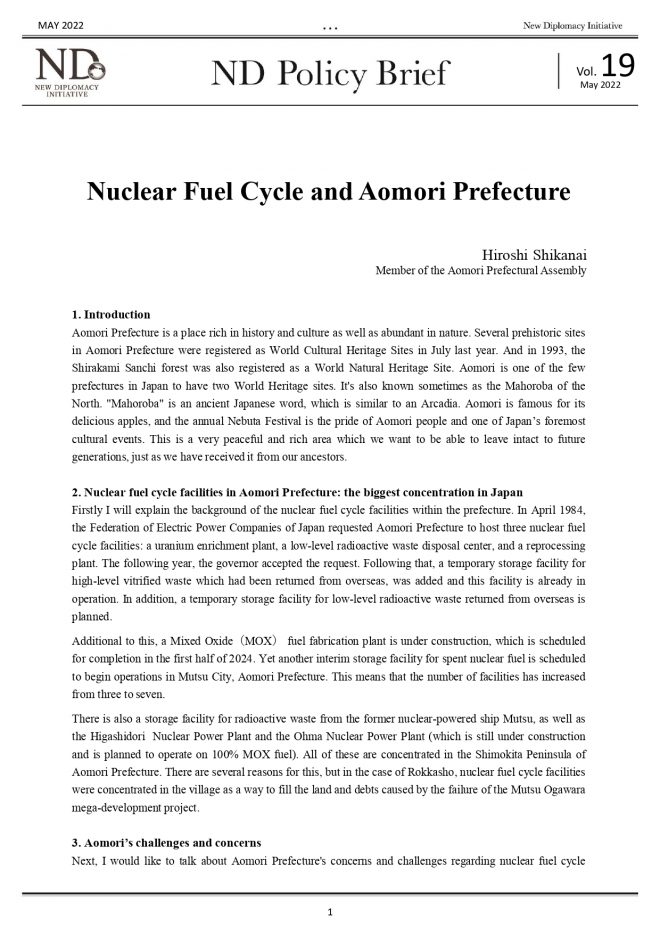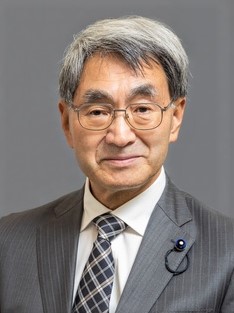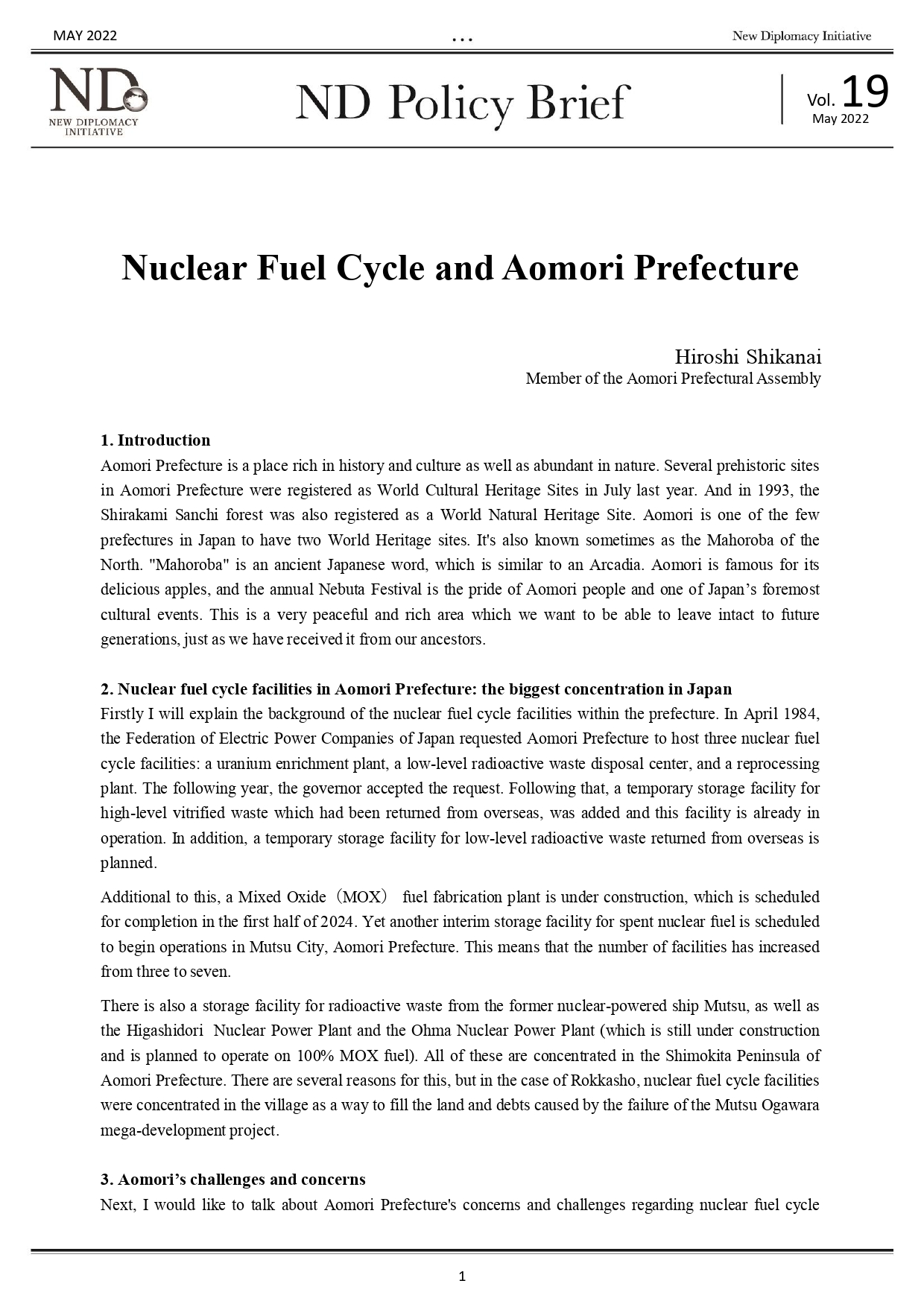Hiroshi Shikanai
Member of the Aomori Prefectural Assembly
1. Introduction
Aomori Prefecture is a place rich in history and culture as well as abundant in nature. Several prehistoric sites in Aomori Prefecture were registered as World Cultural Heritage Sites in July last year. And in 1993, the Shirakami Sanchi forest was also registered as a World Natural Heritage Site. Aomori is one of the few prefectures in Japan to have two World Heritage sites. It’s also known sometimes as the Mahoroba of the North. “Mahoroba” is an ancient Japanese word, which is similar to an Arcadia. Aomori is famous for its delicious apples, and the annual Nebuta Festival is the pride of Aomori people and one of Japan’s foremost cultural events. This is a very peaceful and rich area which we want to be able to leave intact to future generations, just as we have received it from our ancestors.
2. Nuclear fuel cycle facilities in Aomori Prefecture: the biggest concentration in Japan
Firstly I will explain the background of the nuclear fuel cycle facilities within the prefecture. In April 1984, the Federation of Electric Power Companies of Japan requested Aomori Prefecture to host three nuclear fuel cycle facilities: a uranium enrichment plant, a low-level radioactive waste disposal center, and a reprocessing plant. The following year, the governor accepted the request. Following that, a temporary storage facility for high-level vitrified waste which had been returned from overseas, was added and this facility is already in operation. In addition, a temporary storage facility for low-level radioactive waste returned from overseas is planned.
Additional to this, a Mixed Oxide(MOX) fuel fabrication plant is under construction, which is scheduled for completion in the first half of 2024. Yet another interim storage facility for spent nuclear fuel is scheduled to begin operations in Mutsu City, Aomori Prefecture. This means that the number of facilities has increased from three to seven.
There is also a storage facility for radioactive waste from the former nuclear-powered ship Mutsu, as well as the Higashidori Nuclear Power Plant and the Ohma Nuclear Power Plant (which is still under construction and is planned to operate on 100% MOX fuel). All of these are concentrated in the Shimokita Peninsula of Aomori Prefecture. There are several reasons for this, but in the case of Rokkasho, nuclear fuel cycle facilities were concentrated in the village as a way to fill the land and debts caused by the failure of the Mutsu Ogawara mega-development project.
3. Aomori’s challenges and concerns
Next, I would like to talk about Aomori Prefecture’s concerns and challenges regarding nuclear fuel cycle facilities and nuclear power plants.
(1) Concerns about long-term storage and final disposal of radioactive waste
In order to dispel the concerns and problems of Aomori Prefecture, the government has been holding nuclear fuel cycle consultation meetings between the relevant ministers and the governor at every opportunity. The governor has also met with related organizations and received explanations, but the concerns and issues of the people of Aomori have not been alleviated, instead they have increased. In a word, the biggest concern is that the site will become a final disposal site for nuclear waste.
Specifically, the first concern is regarding the high-level vitrified waste which has been returned from overseas. The government has promised that this waste will be removed by April 25, 2045, but we are concerned that it will be stored for a much longer time and eventually become the actual final disposal site. The same is true for the returned low-level radioactive waste. The temporary storage period for these is supposed to be 30 to 50 years, but as of right now, there is only 23 years and 4 months left until the 50 year time limit. The final disposal site for high-level radioactive waste will require about 30 years for investigation and construction, but no candidate site has been decided yet. The schedule, blueprints, and standards for safety inspections have not yet been established. The reason why nuclear waste from overseas is brought into Aomori Prefecture is because the Rokkasho Reprocessing Plant will generate high-level and low-level radioactive waste when it starts operation, and so it was decided to consolidate the returned waste in Rokkasho Village.
The second concern is about the long-term storage of high-level and low-level radioactive waste from the Rokkasho Reprocessing Plant, and the possibility of turning it into a substantial final disposal site. Even if operation of the Rokkasho Reprocessing Plant does not go ahead, there is a concern about the long-term storage of spent nuclear fuel brought in from each nuclear power plant and stored at Rokkasho, and the possibility of it becoming a final disposal site. Incidentally, the operator , Japan Nuclear Fuel Limited (JNFL) , has signed a memorandum of understanding with the prefectural government and the village to take measures, including the removal of spent fuel from the plant, in the event that the reprocessing project becomes extremely difficult to implement.
The spent nuclear fuel interim storage facility in Mutsu City is currently to be used by two companies, Tokyo Electric Power Company (TEPCO) and Japan Atomic Power Company (JAERI), but there is talk of joint use by other power companies. If the spent nuclear fuel is not reprocessed, there are concerns that it will be stored for a long period of time, and in effect become a final disposal site. In addition, spent MOX fuel will be discharged from the Ohma Nuclear Power Plant when it commences operations. There is no facility as yet to reprocess spent MOX fuel so it is likely that it will also be stored for a long time and there are concerns that the Mutsu site will become a final repository for this waste too. If MOX power generation is started at the Higashidori Nuclear Power Plant, the same concerns will arise.
In addition, there are concerns about the long-term storage of radioactive waste generated from the decommissioning and dismantling of nuclear reactors all over Japan, including those at the Higashidori and Ohma nuclear power plants. As for the low-level radioactive waste generated by the decommissioning and dismantling of nuclear power plants, the government has said that it will start disposing of the waste in 2040, but the disposal site has not yet been decided. On the other hand, in 1984, the Federation of Electric Power Companies of Japan indicated to the Aomori administration that disposal facilities for low-level radioactive waste in the prefecture would include decommissioning and dismantling waste from nuclear power plants. Therefore, there is a growing concern that the Rokkasho Low-Level Radioactive Waste Disposal Center will be used to dispose of such waste.
As you can see, because Aomori Prefecture has a reprocessing plant, a low-level radioactive waste disposal center, basically, because nuclear fuel cycle facilities are sited here, various kinds of nuclear waste have already been brought in one after another and there are serious concerns that this will continue into the long-term future.
(2) Concerns regarding safety
Another major concern is the safety of reprocessing plants, MOX fuel plants, and nuclear power plants. This concern has not been dispelled. Basically, there are doubts about the safety assurances of the nuclear operators and the government. Specifically, there are concerns about accidents caused by social and natural factors, such as the technology for vitrification at the reprocessing plant, which is yet to be demonstrated; aircraft collisions at the U.S. Misawa Air Base; and the existence of active faults. In addition, there are concerns about the effects of radioactive materials such as tritium which will be released in large quantities from the reprocessing plant into the air and sea, as well as reputational damage. There are many other safety concerns as well, which are too numerous to mention here.
4. The reality and contradictions of the nuclear fuel cycle as seen from Aomori Prefecture
So where are these concerns coming from? I would like to point out some of the realities and contradictions of the nuclear fuel cycle that are the source of our anxiety.
First of all, the explanations and promises made by the Federation of Electric Power Companies of Japan (FEPC), the operators, and the government in April 1984, when the original request was made to locate a nuclear fuel cycle facility in Aomori, are impossible to implement. Specifically, one of the main pillars of the nuclear fuel cycle– commercializing fast breeder reactors, so-called “dream reactors,” and using plutonium, is just that—a dream. And it is also quite difficult to explain how Aomori Prefecture will not become a nuclear waste dumping ground for high-level radioactive waste and other materials. In reality, low-level disposal centers are already in operation. Furthermore, the Fukushima nuclear accident and other factors have made it clear that the safety of nuclear facilities cannot be ensured by the government and the operator, even though it is their responsibility. In addition, the nuclear fuel cycle facilities can only contribute to the development of the region temporarily or transiently, they will never fulfil the Prefecture’s original goal economic prosperity through advancement of industrial structure.
Secondly, despite the failure of Japan’s fast reactor, despite our surplus of plutonium, and inability to secure a disposal site for high-level radioactive waste and other nuclear waste, we continue to promote the nuclear fuel cycle and the policy to reprocess all spent nuclear fuel. In reality, the nuclear fuel cycle cannot be considered a national policy or a national project. First of all, many of the government’s nuclear development and utilization plans, basic energy plans, and plans for the final disposal of specific radioactive wastes, which have been approved by the Cabinet or agreed upon by the government, have not been realized. Secondly, there are few explanations that the public can understand and trust about the plutonium utilization plan, the schedule of the final disposal plan for high-level radioactive waste, the plan for the second reprocessing plant, and the plan for the reprocessing plant for spent MOX fuel. The schedule for the high-level radioactive waste disposal plan should have been decided by the Cabinet, but we still don’t even know when that will be, so I have to say that this is not a national policy.
Thirdly, the public’s trust in the government and the operators has been eroded, even though public understanding and cooperation are essential for the promotion of the nuclear fuel cycle policy. Accidents at nuclear facilities and scandals involving operators, the rash of data falsification and inadequate compensation for victims of the Fukushima Daiichi nuclear accident, the decision to release contaminated water into the ocean, the start of a survey in Hokkaido for a high-level radioactive waste disposal site, the plan for shared use of the interim storage facility in Mutsu City, and so on and so on. The government and operators are not keeping the promises they made to the public. This means that no municipality will be willing to take on the disposal of nuclear waste or to approve new nuclear facilities. Under these circumstances, surely it is impossible to promote the nuclear fuel cycle policy.
Lastly, the premise for promoting the nuclear fuel cycle has been lost due to the expansion of renewable energy and its lower cost. The only reason why the government still insists on the nuclear fuel cycle is because it cannot secure a final disposal site for nuclear waste, including spent nuclear fuel, and it is using the nuclear fuel cycle as an excuse or pretext to postpone the problem, and as a result, Aomori Prefecture is about to become its biggest victim.
5. Our demands to the government and operators
What we ask from the government and the operators is that if they want to proceed with the nuclear fuel cycle policy, clear decisions should be made immediately, instead of putting off important issues and avoiding commitments. The future of the nuclear business must be explained clearly to the public, and the public’s understanding and trust in the nuclear policy must be obtained. First of all, the amount of radioactive waste expected to be generated and the plan for final disposal must be made clear. Second, the government must explain the overall picture of the nuclear fuel cycle, including specific plans for the use of plutonium, plans for a second reprocessing plant and a reprocessing plant for MOX fuel. Third, a comparison of the costs and risks of the nuclear fuel cycle, direct disposal of spent nuclear fuel, and renewable energy must be undertaken.
However, these are things that could not be done in the past, and we feel that it is now too late to achieve them. Therefore, what is required today is a change in policy. Specifically, we need to stop the nuclear fuel cycle policy and the policy of reprocessing all spent nuclear fuel, and change to direct disposal of spent nuclear fuel. In other words, the reprocessing plant and MOX fuel fabrication plant should be cancelled. And we should stop operating and building new nuclear power plants so we do not increase the amount of radioactive waste, for which it is difficult to secure a final disposal site. We need the understanding and cooperation of the local governments where nuclear power plants and nuclear fuel cycle facilities are located, so we need to change the financial system, such as the subsidies under the Three Power Sources Law and the budget for nuclear fuel promotion, to a system and content that support the financial management and regional development of the local governments. In addition, the government must directly address the issue of securing a final disposal site for all radioactive waste, including the direct disposal of spent nuclear fuel, as a matter of national concern. Furthermore, the policy must be changed so that no region or municipality is forced to make sacrifices. There are more demands, but unfortunately space does not allow me to mention them all.
6. Conclusion
As I have said, the nuclear fuel cycle policy is unnecessary and unfeasible, and we should abandon nuclear power and the nuclear fuel cycle policy as soon as possible. It is absolutely necessary to avoid forcing certain areas, especially Aomori Prefecture, to bear the anxiety and long-term risk of nuclear waste, such as spent nuclear fuel and radioactive waste returned from overseas. We should not postpone addressing the problems, but rather put all our efforts into finding some solution to the negative legacy that occurred in our time, and not impose it on the next generation. Aomori Prefecture has been cooperating with the nuclear fuel cycle policy in an attempt to promote regional development. However, this national policy has not been realized, and far from being a true form of regional development, Aomori is being turned into the largest nuclear waste dump in Japan. The current situation is completely different from what was initially explained and promised by the government and the operators. Therefore, if Aomori Prefecture does not allow the delivery of nuclear waste, including spent nuclear fuel, and stops cooperating in the nuclear fuel cycle policy, the national government will have to change its policy. I hope that this will be realized, and with this hope, I conclude my proposal.
※This paper is based on the author’s presentation at the international symposium “Growing Plutonium Stockpiles and the Rokkasho Reprocessing Plant: Reality of Nuclear Fuel Cycle and Security in East Asia” , Dec. 18-19, 2021. The views expressed here are those of the author.
※This project is supported by a grant from “act beyond trust” (abt) .




